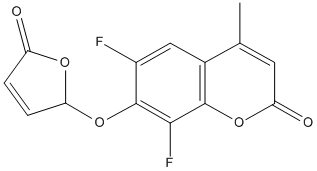GC486
General
Type : Strigolactone receptors ligand || Fluorescent Probe || Coumarin || DifMU derivative
Chemical_Nomenclature : 6,8-difluoro-4-methyl-7-[(5-oxo-2H-furan-2-yl)oxy]chromen-2-one
Canonical SMILES : CC1=CC(=O)OC2=C(C(=C(C=C12)F)OC3C=CC(=O)O3)F
InChI : InChI=1S\/C14H8F2O5\/c1-6-4-10(18)20-13-7(6)5-8(15)14(12(13)16)21-11-3-2-9(17)19-11\/h2-5,11H,1H3
InChIKey : WPWPRHRHWOWCBQ-UHFFFAOYSA-N
Other name(s) : (+\/-)-GC486, DiFMU-oxo-dihydrofuran-yl, 6,8-difluoro-4-methyl-7-[(5-oxo-2,5-dihydrofuran-2-yl)oxy]-2H-chromen-2-one
MW : 294.21
Formula : C14H8F2O5
CAS_number :
PubChem :
UniChem :
Iuphar :

Target
Families : RsbQ-like
References (2)
| Title : Expansion of the Strigolactone Profluorescent Probes Repertory: The Right Probe for the Right Application - de Saint Germain_2022_Front.Plant.Sci_13_887347 |
| Author(s) : de Saint Germain A , Clave G , Schouveiler P , Pillot JP , Singh AV , Chevalier A , Daignan Fornier S , Guillory A , Bonhomme S , Rameau C , Boyer FD |
| Ref : Front Plant Sci , 13 :887347 , 2022 |
| Abstract : de Saint Germain_2022_Front.Plant.Sci_13_887347 |
| ESTHER : de Saint Germain_2022_Front.Plant.Sci_13_887347 |
| PubMedSearch : de Saint Germain_2022_Front.Plant.Sci_13_887347 |
| PubMedID: 35720613 |
| Title : An histidine covalent receptor and butenolide complex mediates strigolactone perception - de Saint Germain_2016_Nat.Chem.Biol_12_787 |
| Author(s) : de Saint Germain A , Clave G , Badet-Denisot MA , Pillot JP , Cornu D , Le Caer JP , Burger M , Pelissier F , Retailleau P , Turnbull C , Bonhomme S , Chory J , Rameau C , Boyer FD |
| Ref : Nat Chemical Biology , 12 :787 , 2016 |
| Abstract : de Saint Germain_2016_Nat.Chem.Biol_12_787 |
| ESTHER : de Saint Germain_2016_Nat.Chem.Biol_12_787 |
| PubMedSearch : de Saint Germain_2016_Nat.Chem.Biol_12_787 |
| PubMedID: 27479744 |
| Gene_locus related to this paper: pea-RMS3 |